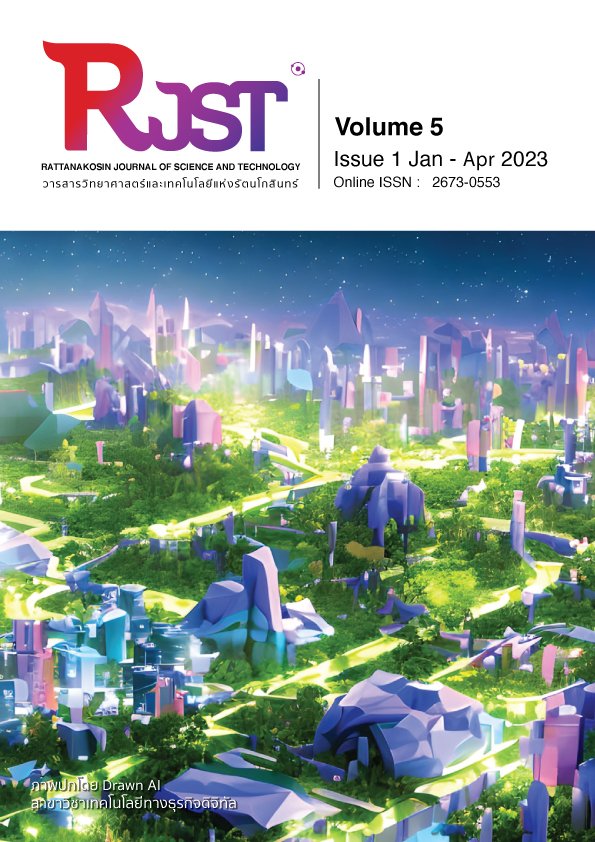Monitoring of Airborne Microorganisms and Environmental of Laboratory Rooms, Faculty of Science and Technology, Rajamangala University of Technology Rattanakosin
Main Article Content
Abstract
Airborne microorganism is one factor that must be considered and poses a high risk to the health of indoor workers. Therefore, indoor air quality measurements must be constantly monitored because if the air quality is below standard, microorganisms will not be inhibited and spread throughout the facilities. The aims of this study were to determine the type and presence of microorganisms including measurement of the environmental conditions of six laboratories at the Faculty of Science and Technology, Rajamangala University of Technology Rattanakosin. The air sample contaminated by bacteria and fungi was collected using settle plate method in the morning and afternoon for three weeks. Also, the relative humidity, temperature and Illuminance were investigated. The results showed that the Microbiology Laboratory had the highest presence of bacteria of 76.5 CFU/dm2/h and other laboratories showed a range between 1.6 – 43.0 CFU/dm2/h. Also, the fungal presence at the Microbiology Laboratory was at the highest (28.3 CFU/dm2/h) and other laboratory had a range between 4.7-23.6 CFU/dm2/h with environmental conditions of relative humidity (37.4 – 50.2 %RH), temperature (26.6 – 28.1 °C) and Illuminance (447 – 687 Lux). Comparison with the index of microbial air contamination (IMA) has found average levels in the six rooms were fair to very good. The greatest number of bacteria was Bacillus sp. followed by Staphylococcus sp. In addition, the types of fungi found were Aspergillus sp., Penicillium sp., Cladosporium sp. and Curvularia sp. These microorganisms are generally present in laboratory environments. However, allergy or more negative outcomes on some patients with respiratory diseases can be prevented if contamination is at safe levels.
Article Details

This work is licensed under a Creative Commons Attribution-NonCommercial-NoDerivatives 4.0 International License.
The content within the published articles, including images and tables, is copyrighted by Rajamangala University of Technology Rattanakosin. Any use of the article's content, text, ideas, images, or tables for commercial purposes in various formats requires permission from the journal's editorial board.
Rajamangala University of Technology Rattanakosin permits the use and dissemination of article files under the condition that proper attribution to the journal is provided and the content is not used for commercial purposes.
The opinions and views expressed in the articles are solely those of the respective authors and are not associated with Rajamangala University of Technology Rattanakosin or other faculty members in the university. The authors bear full responsibility for the content of their articles, including any errors, and are responsible for the content and editorial review. The editorial board is not responsible for the content or views expressed in the articles.
References
World Health Organization. 2021. WHO global air quality guidelines: particulate matter (PM2.5 and PM10), ozone, nitrogen dioxide, sulfur dioxide and carbon monoxide. WHO Press, Geneva. Epidemiology. 32, 751–758.
Zhang, X., Wu, J., Smith, L. M., Li, X., Yancey, O., Franzblau, A., & Neitzel, R. L. 2022. Monitoring SARS-CoV-2 in air and on surfaces and estimating infection risk in buildings and buses on a university campus. Journal of Exposure Science & Environmental Epidemiology. 32, 751–758.
ปมณฑ์ ภูมาศ. 2563. การตรวจสอบคุณภาพอากาศภายในห้องเรียนบางห้องของคณะวิทยาศาสตร์และเทคโนโลยีมหาวิทยาลัยราชภัฏเชียงใหม่. วารสารวิทยาศาสตร์และเทคโนโลยี มหาวิทยาลัยธรรมศาสตร์. 91-100.
Katsakorn, A. and Phangchandha, R. (2015). Evaluation of indoor air quality conditions in classrooms, JPE 1: 238-247.
Stryjakowska-Sekulska, M., Piotraszewska-Pajak, A., Szyszka, A., Nowicki, M., & Filipiak, M. (2007). Microbiological quality of indoor air in university rooms. Polish Journal of Environmental Studies. 16(4), 623–632.
สุนทรี สวนทับทิม และพรเพ็ญ ก๋ำนารายณ์ 2563. การตรวจวัดสภาพแวดล้อมและการสำรวจชนิดและปริมาณของจุลินทรีย์ในอากาศของห้องปฏิบัติการวิทยาศาสตร์การแพทย์. วารสารวิทยาศาสตร์และเทคโนโลยี มหาวิทยาลัยธรรมศาสตร์. 1462-1472.
จักรพงษ์ นิมานะ ศิริลักษณ์ เจริญรัตน์ และวราลี บุญพิทักษ์สกุล. 2557. การปนเปื้อนจุลินทรีย์ในอากาศของห้องปฏิบัติการ คณะวิทยาศาสตร์มหาวิทยาลัยพายัพ. วารสารวิทยาศาสตร์ มข. 42(2). 341-349.
Pasquarella, C., Pitzurra, O. & Savino, A. (2000). The index of microbial air contamination. Journal of hospital infection. 46, 241-256.
กติกา สระมณีอินทร์ กานต์นลินญา บุญที สิริวรัญญา ศรีษาคากุลวัฒน์ และยุภารัตน์ เครือวงษา. (2559). การสำรวจชนิดและปริมาณเชื้อราที่แขวนลอยในอากาศ อาคารวิจัยคณะวิทยาศาสตร์ มหาวิทยาลัยอุบลราชธานี. การประชุมวิชาการระดับชาติ มหาวิทยาลัยเทคโนโลยีราชมงคลรัตนโกสินทร์ ครั้งที่ 1. 438-445.
วรัญญา แสงเพ็ชร์ส่อง. (2529). ความรู้เบื้องต้นเกี่ยวกับโรคติดเชื้อ. พิมพ์ครั้งที่ 2. กรุงเทพฯ บัณฑิตการพิมพ์. 47-49.
ศิริพร ศรีเทวิณ และกาญจณา นาถะพินธุ. (2555). การปนเปื้อนเชื้อจุลินทรียในอากาศในโรงพยาบาลขนาดที่แตกต่างกัน. วารสารวิจัยมหาวิทยาลัยขอนแก่น. 12(1): 92-101.
Amirmajdi, M. M., Amirmajdi, N. A. M., Mashhadi, I. E., Azad, F. J., Afshari, J. T., & Shakeri, M. T. (2011). Alternaria in patients with allergic rhinitis. Iranian Journal of Allergy, Asthma and Immunology, 10(3), 221-226.
Bugajny, A., Knopkiewicz, M., Piotraszewska-Pajk, A., Sekulska-Stryjakowska, M., Stach, A., & Filipiak, M. (2005). On the Microbiological Quality of the Outdoor Air in Poznañ Poland. Polish Journal of environmental studies, 14(3), 287-293.


